STUNNING!
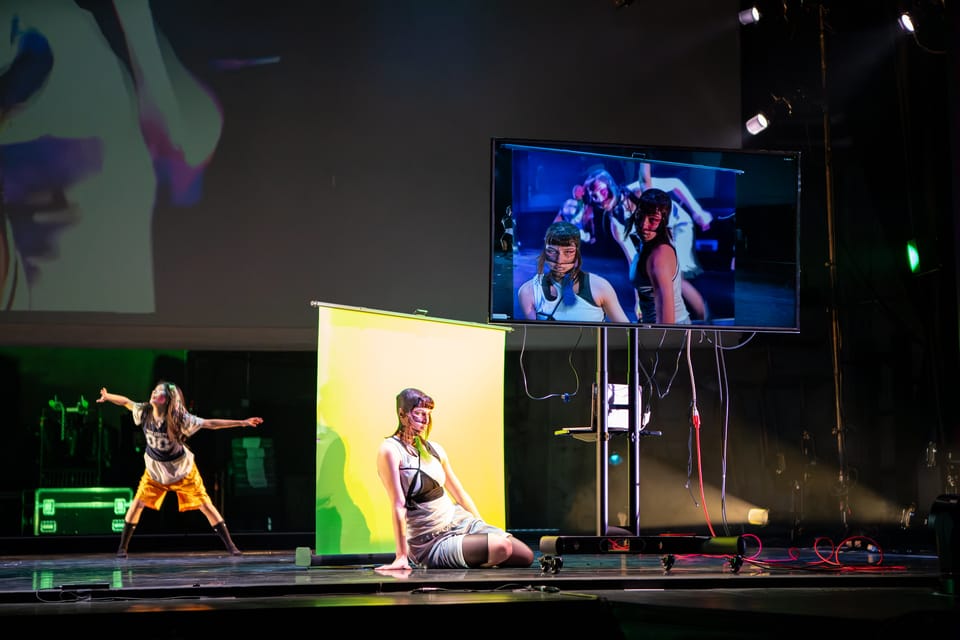
An MFA Thesis
MUSIC COMPOSER
Cody Jensen
DANCERS
Nawal Assougdam
Jenny Bo
Marlee Doniff
Emma Kunz
Brooklyn Lutz
Tessa Olson
Avi Pellegrinetti
Cheyenne Smith
SCREEN GOBLIN
Avi Pellegrinetti
DRAMATURG
Tessa Olson
NOTES
Stunning! explores performing beauty for the screen, and what it means to “stun” audiences into attention. Gabriel learned how to use live-manipulated Zoom videos, green screens, and a roving monitor while in quarantine and has passed it along to their cast to create a world for their avatars. Gabriel is thrilled to combat brain-rot with such talent!
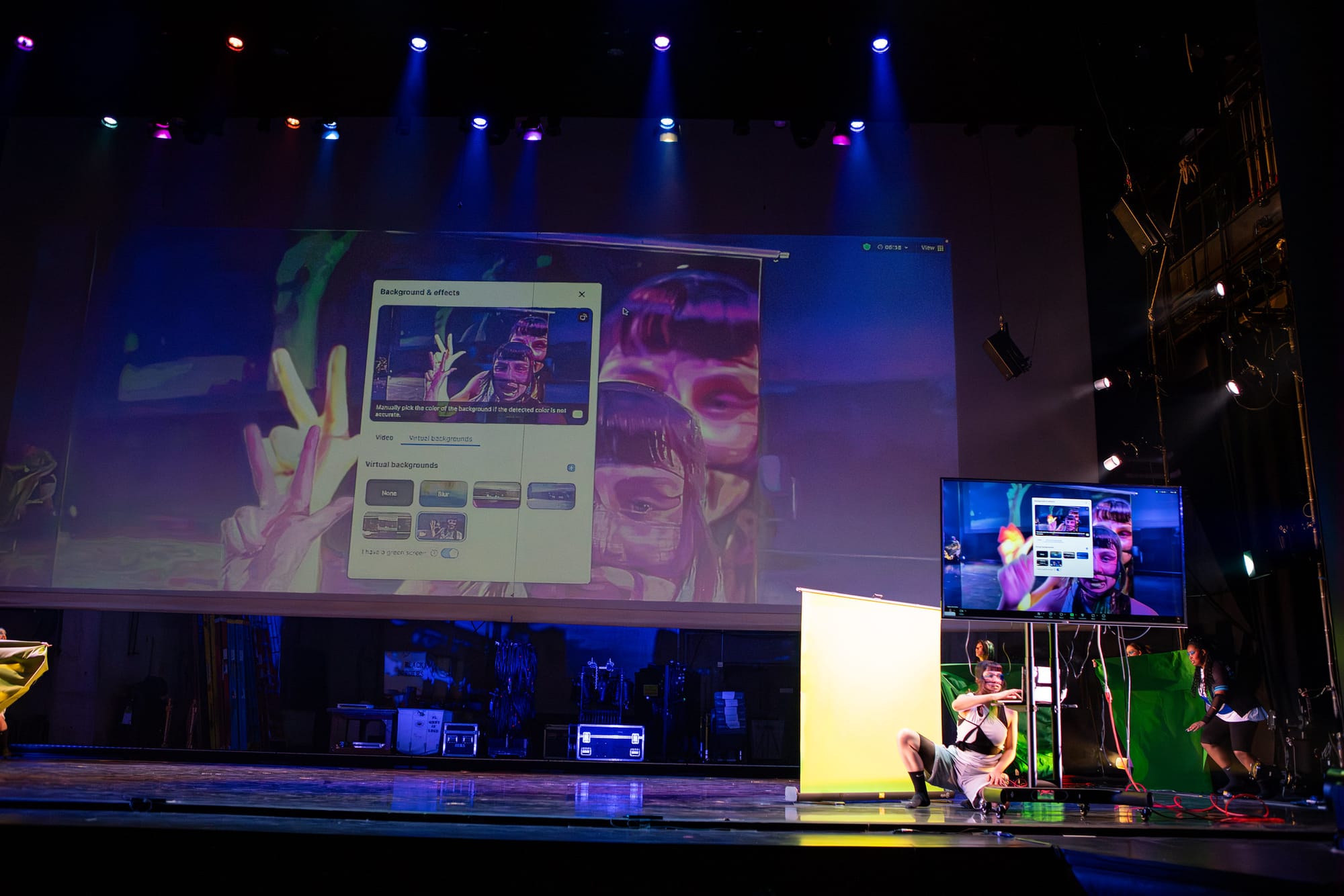
COSTUME COORDINATOR
KHetag Tsabolov
LIGHTING DESIGNER
Cameron L. Strandin
SOUND DESIGNER
Erica Feagin
MEDIA DESIGNER
Nicholas J. Taboni
STAGE MANAGER
Dominic Bradburn
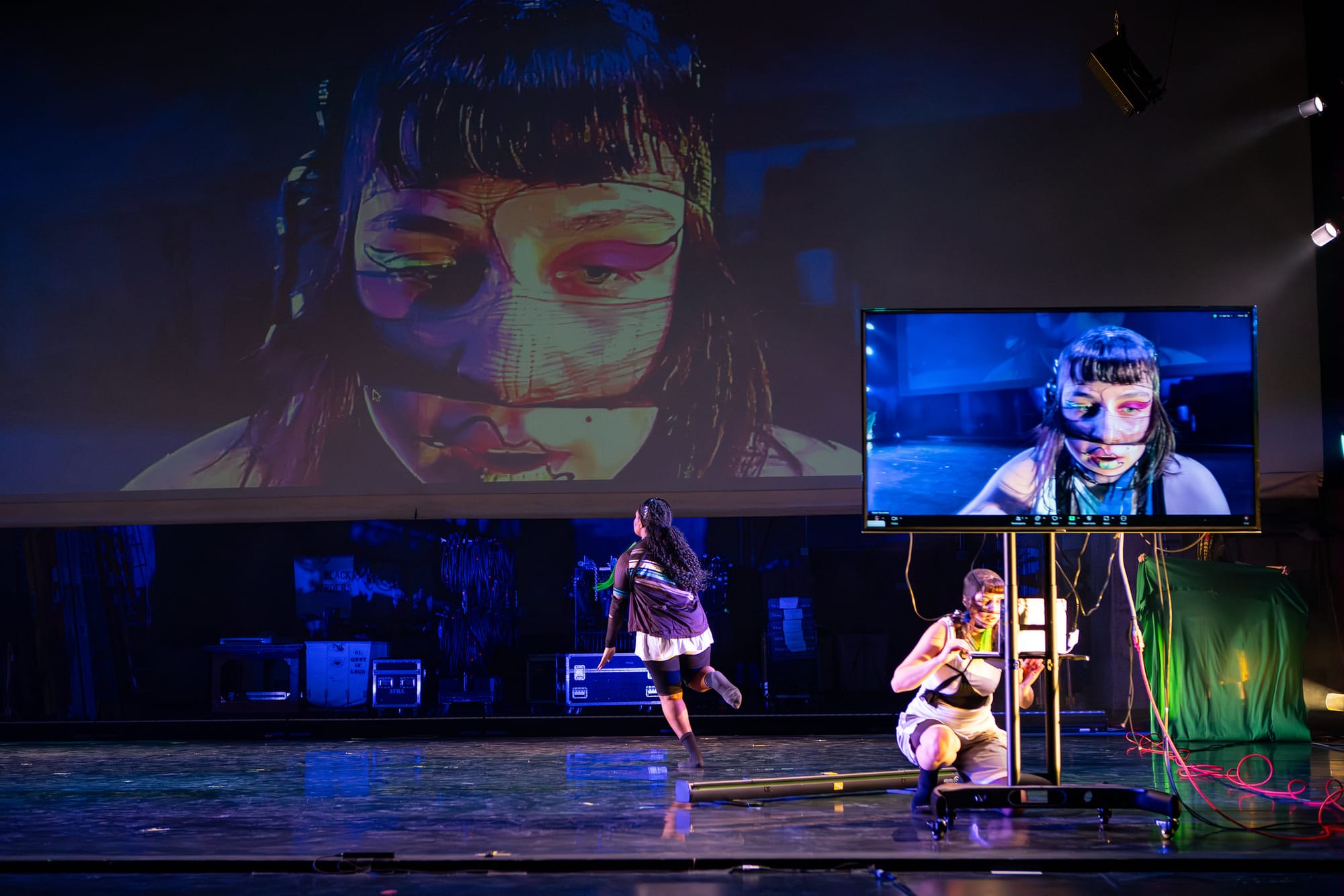
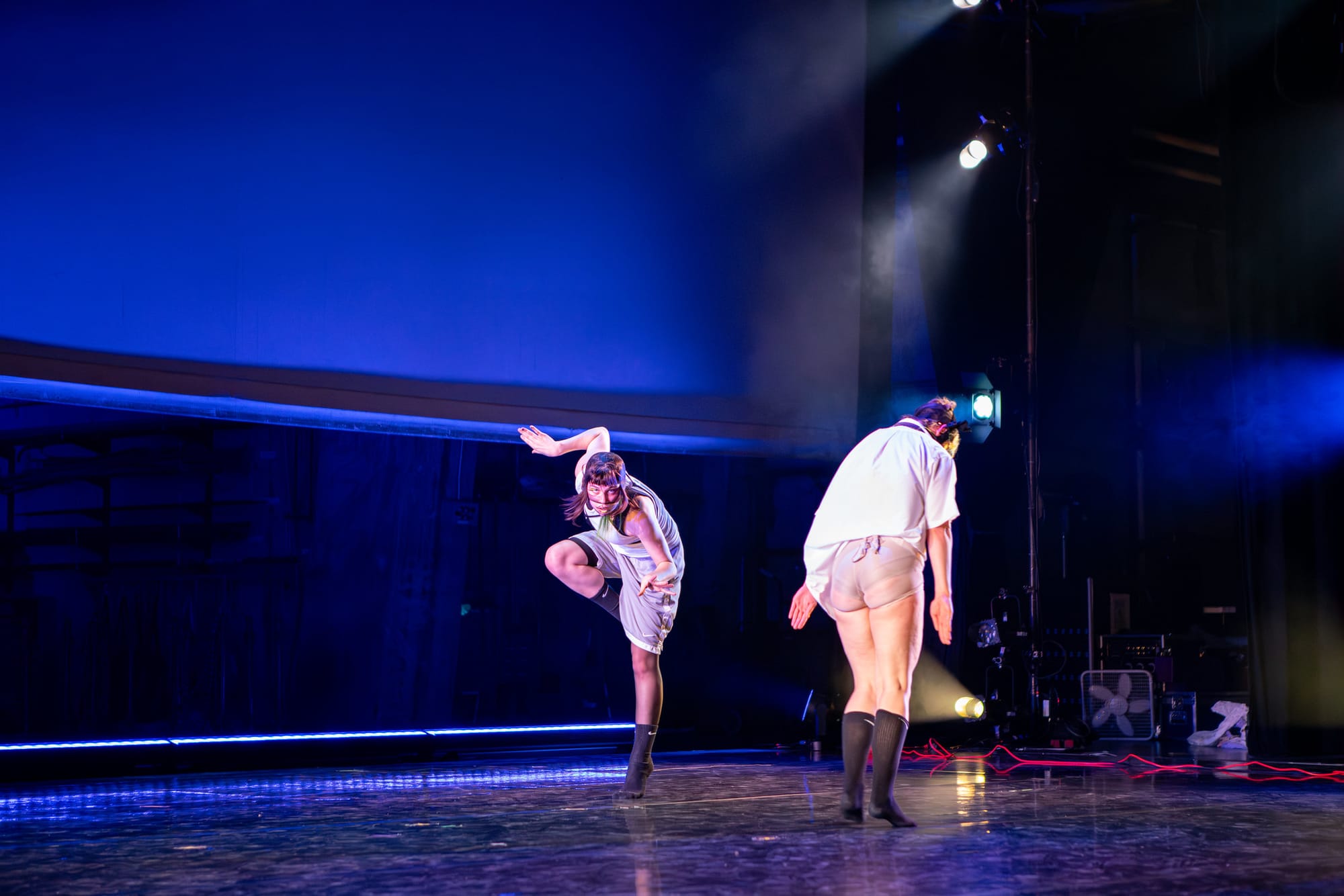
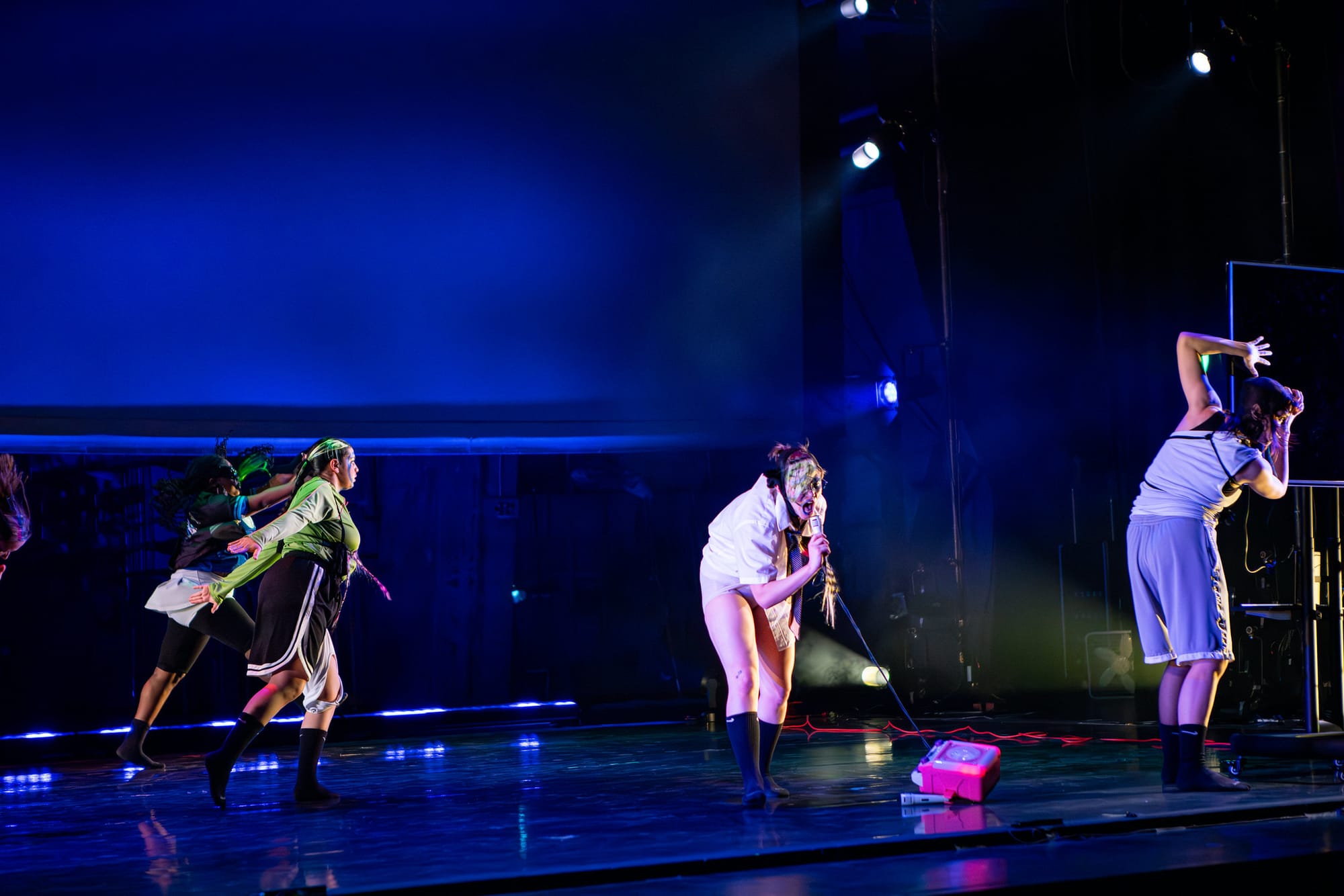
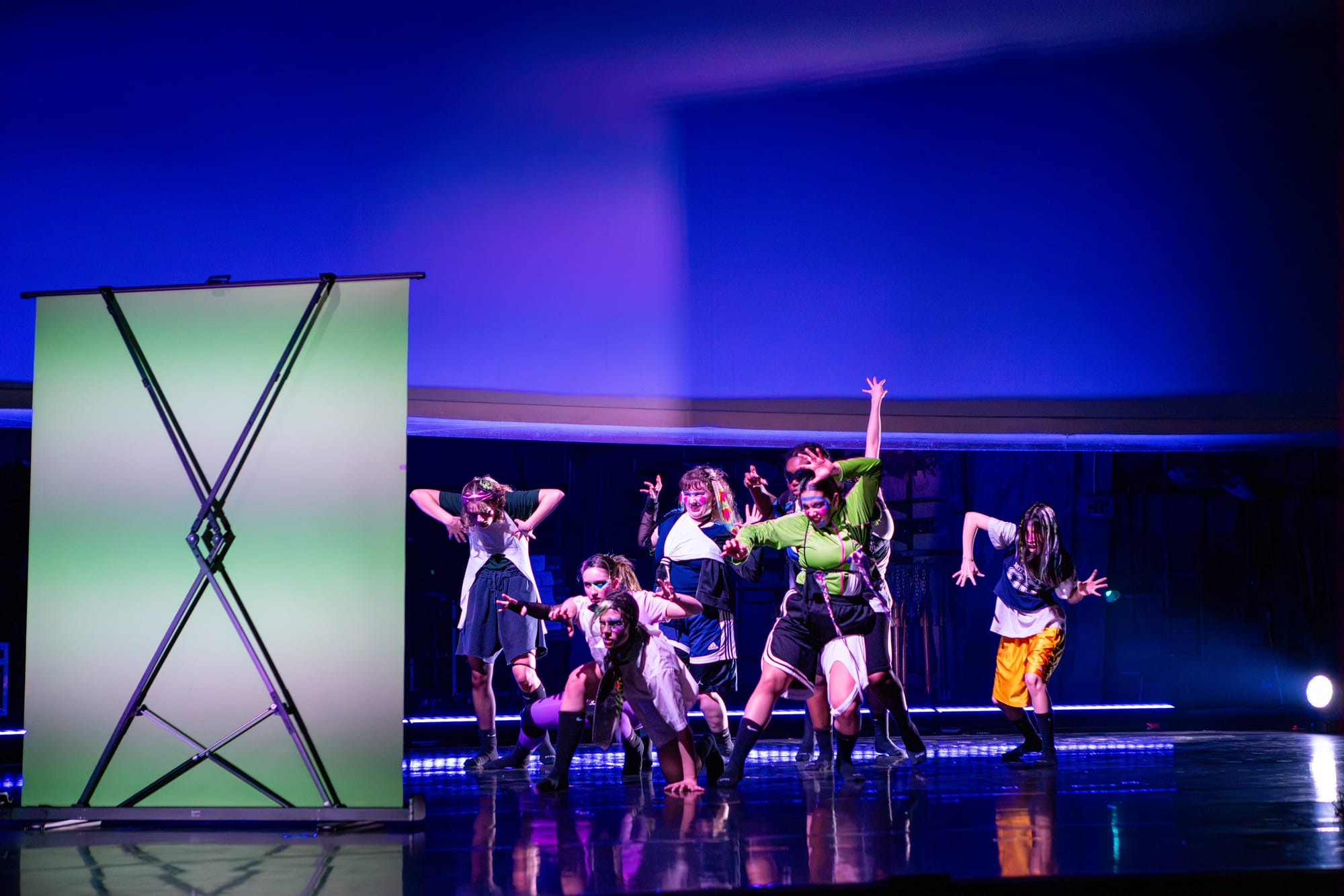
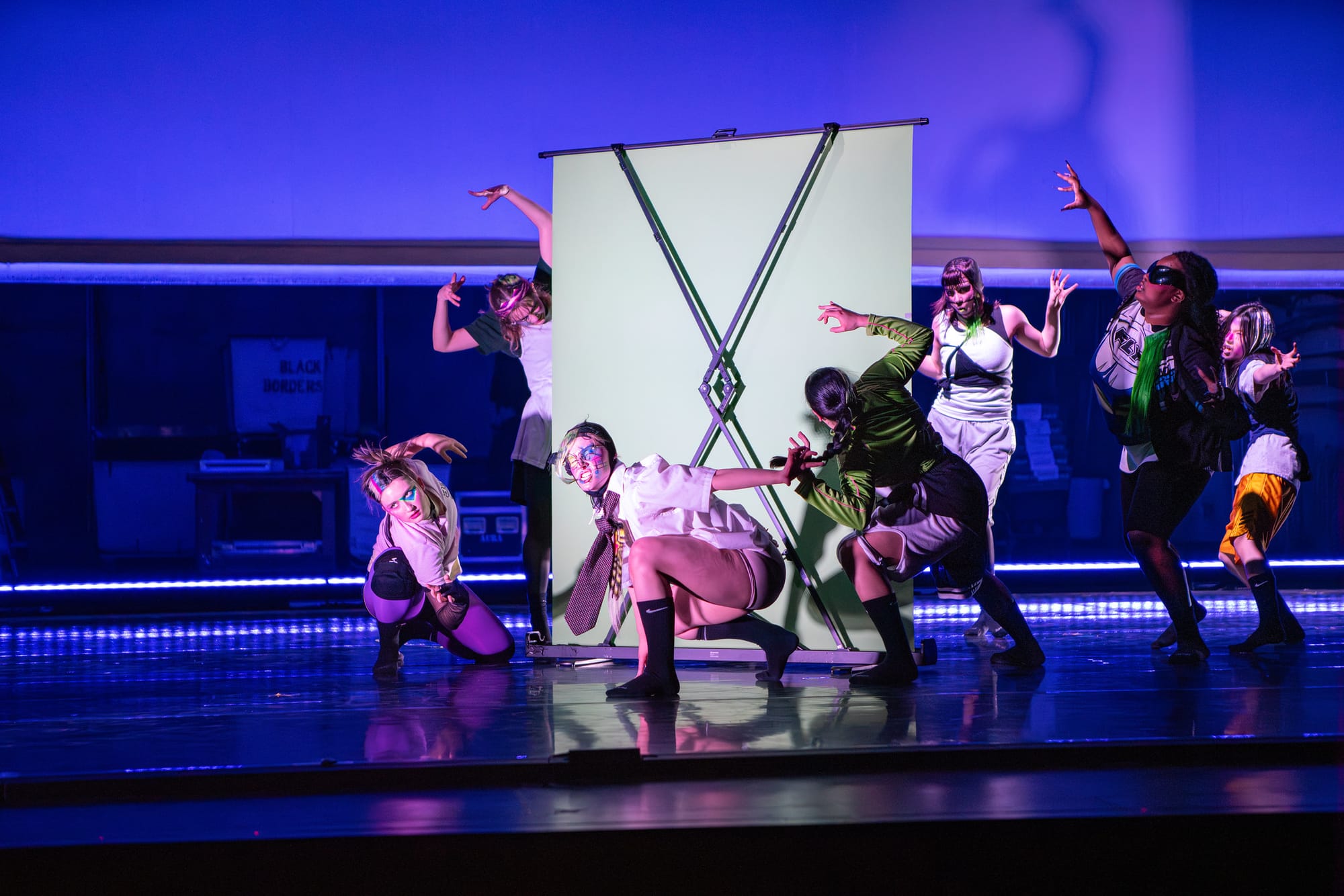
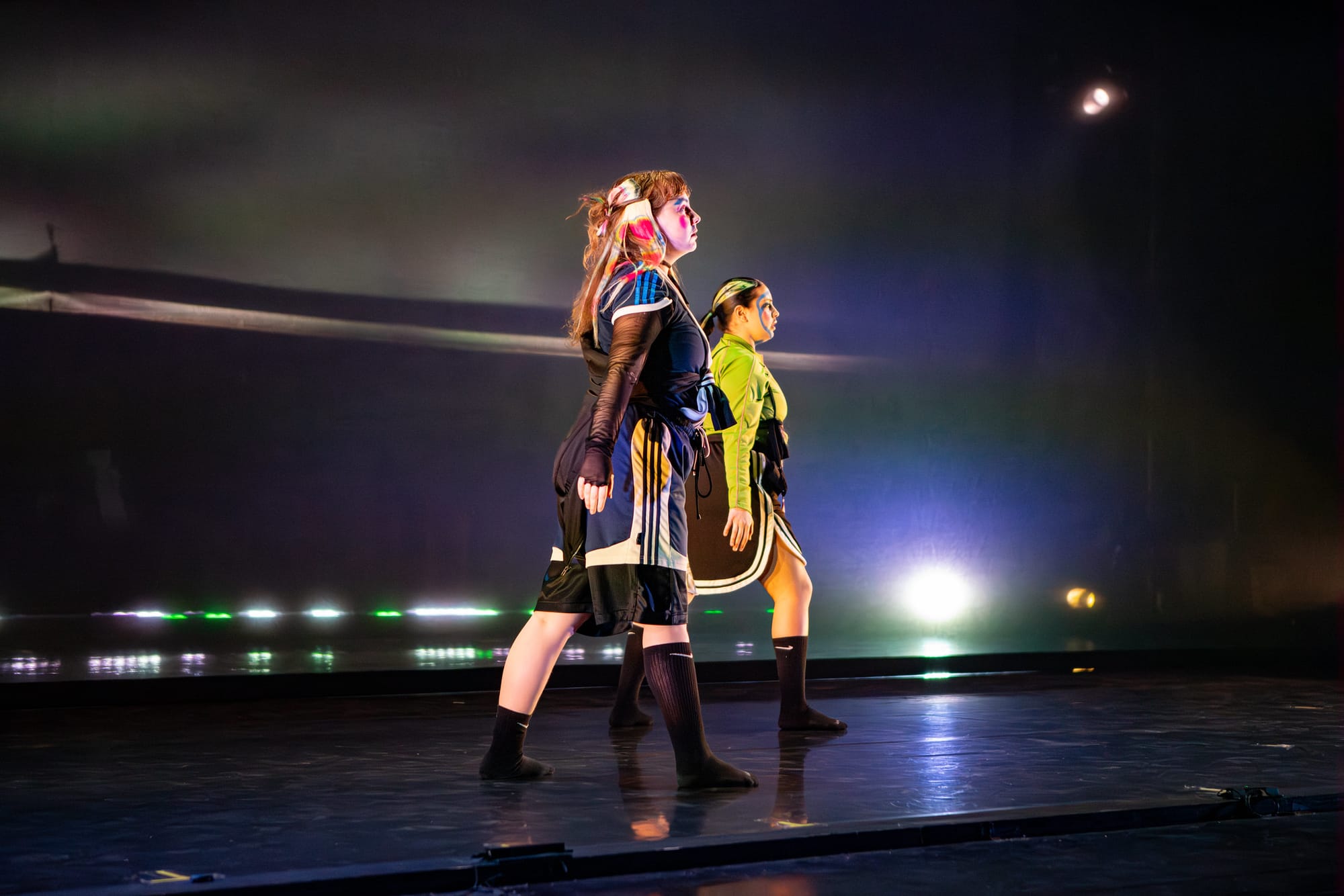
THESIS ABSTRACT: (250-500 words) In brief, describe what your MFA thesis is about.
This thesis explores the aesthetics and politics of my 2025 performance work, Stunning!. The dance loops screen recordings, dancing bodies, and browser-based environments to stage questions about presence, surveillance, labor, and digital life. Anchored in rehearsal notes and memoir, the writing traces how a glitch-driven loop traps the performance inside a digital world. The World is created using Zoom, a rolling TV, avatars, and (as the online listing optimized for digital traffic is written) an "Elgato Green Screen - Collapsible Chroma Key Backdrop, Wrinkle-Resistant Fabric and Ultra-Quick Setup for background removal for Streaming, Video Conferencing, on Instagram, TikTok, Zoom, Teams, OBS."
The work emerged from the pandemic-era shift in how we attune ourselves to bodies and performance through screens. I draw from my 2020 experiences watching virtual drag through Instagram Live to consider how the loop is a method of reframing the reproduction of movement on screen. In this framing, looping is not just a technical device of faithful reenactment, but a distortion and an attempt to make visible the power structures embedded in repetition.
I explain how the dancers become avatars in a looped choreography, bodies and workers consumed by endless scroll. During the performance they are not simply repeating choreographed movements but are becoming digital residue of previous labor: glitched, misaligned presence which mimics our own lack of narrative closure and control over an increasingly algorithmic experience of the digital.
This work contributes to current discussions on mimetic digital embodiment, emotional labor, and the aesthetics of the attention economy. By locating performance within the desktop, (a place where history, attention, and algorithm intersect on a research-based two-dimensional plane) I suggest that dance can offer interruption and rehearsal for alternative modes of performance and living.
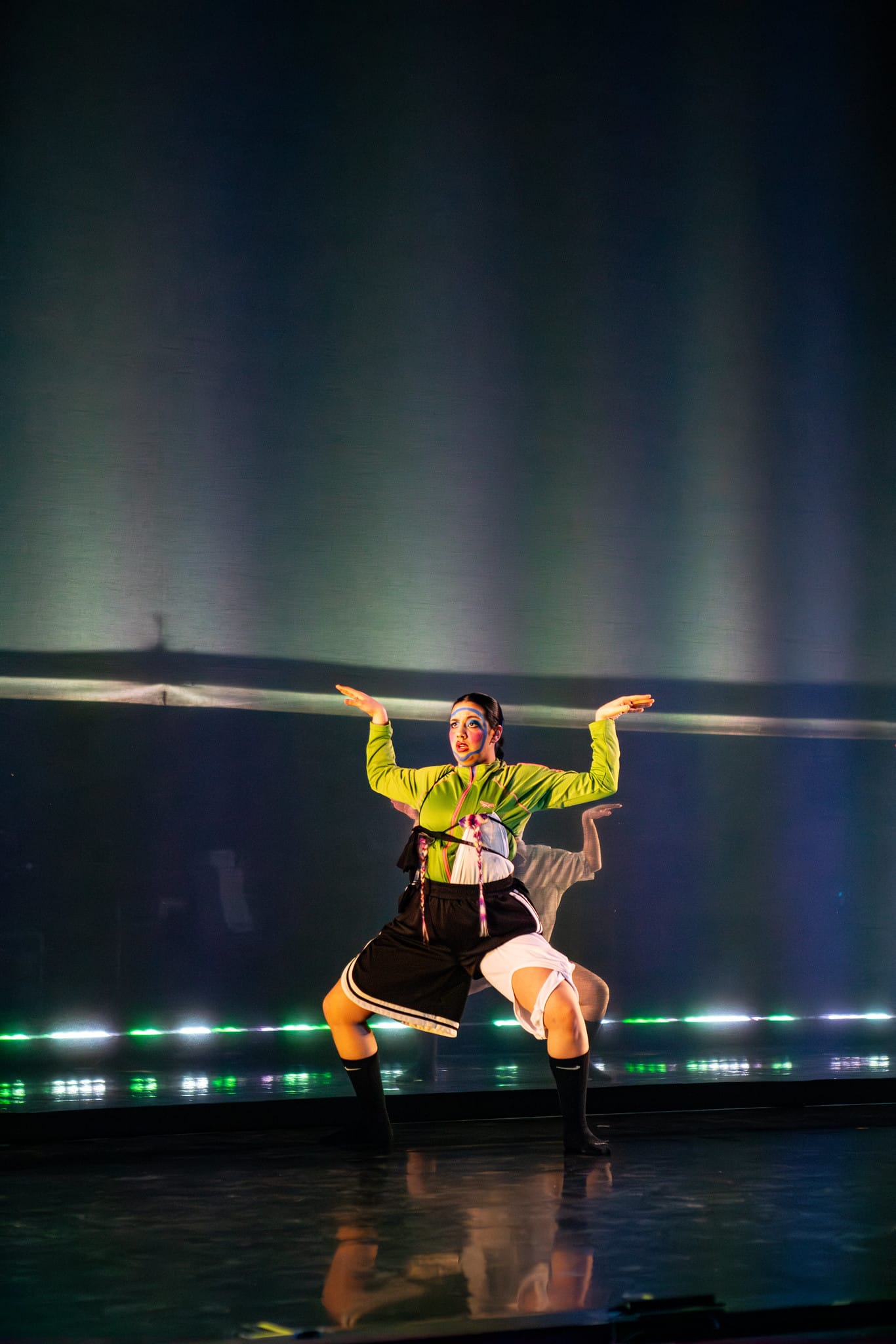
Introduction
The multimedia dance performance Stunning!, was created by the February Dance 2025 Team, and premiered in January 2025 in Urbana, Illinois amidst …amidst…. amidst. Stunning! was performed using the videoconferencing platform Zoom and deploys unconventional theatrical framing devices of: virtual background as set design, non-theatrical setting, long tracking shot, and avatar. The use of Zoom for this onstage thesis performance attempts to reposition the desktop from an engineering tradition of research tool to a performance tradition of a stage. The tradition I mention here is twofold. One tradition that is personal and of my family and one that is positional of the Spartan-like nation of my birth, America. During the MFA process, I was convinced that labeling myself as 'a person in the pursuit of dance' sufficiently distanced myself from the traditions of engineering I have felt guilty about directly benefitted from. Those being my status as a child of engineers, and my experience as a former agent of soft diplomacy via the Fulbright Program. It is through my personal experience that I have developed a definition of engineering as a discipline which aims to create and procure the advancement of an Empire's power through the development of technologies. Particularly those interested in human communication.
The repositioning I mention turning a research tool into a stage is a result of experiments I performed while isolated in COVID lockdown. Expanding these experiments as a cast shaped how choreographic inquiry took place throughout rehearsals. And because this repositioning is an active process, I am using this writing to further learn what producing this performance taught me both as choreographer and witness.
The timeline in which widely accessible technology has progressed from telephones to instant video communication feels like science fiction. To me. Telecommunication technology like that of Zoom entered our daily life in such a rapid way that culture is still trying to adapt to. This dance questioned how the knowledge of the dance performer and the aesthetics of the theatre provide an understanding of this rapid adaptation through a development of choreographic tools and culture. The stress and vulnerability of navigating developing technologies in front of an audience, of unmuting, of duo identification, of pinning video, of screensharing, (is a known and hated experience by many, is the what we learned to do, is what the dance drew from). There is a lack of understanding about how these technologies operate (how things work, what to do when things go wrong, what things are going wrong in the first place) that has persisted despite a mass adoption of them as solutions for the societal shifts of our increasingly complicated present (anchor in this zoom moment, presenting a way for dealing with the future, presenting a way to bring out a sincere, honest, and vulnerable performance in the dancers, and a resonance with the audience). And when things go awry, it is easier to freeze than to move.
This written thesis furthers these goals for the stage performance which can be summarized as: to create a performance that at its core uses my experience of two forms of knowledge; that of the dancer, and that of the theatrical audience. My knowledge as a dancer is created by the emphasises of my training to move assuredly and meaningfully while in the face of stress and unknowns. While my knowledge as a theatrical audience member has conditioned me with certain expectations for how technology is used so that it can be controlled, in a repeated and predictable pattern with little room for things to go wrong. The final dance felt alive and precarious because of its commitment to finding new way for technology to be used in a show that builds on what . In a way that stuns and is Stunning!
This is a performance that demands choice. Where do you look? What do you remember? Which loop did you follow, and what do you miss? The work doesn't answer—it replays. Building and breaking live for an audience to navigate distraction and redirection while in an auditorium of other people. And in doing so, resisting the passive, and solitary habits of algorithmic life.
This is the labor of performance in the age of the scroll: not to escape the loop, but to glitch. Visibly, critically, stunningly.
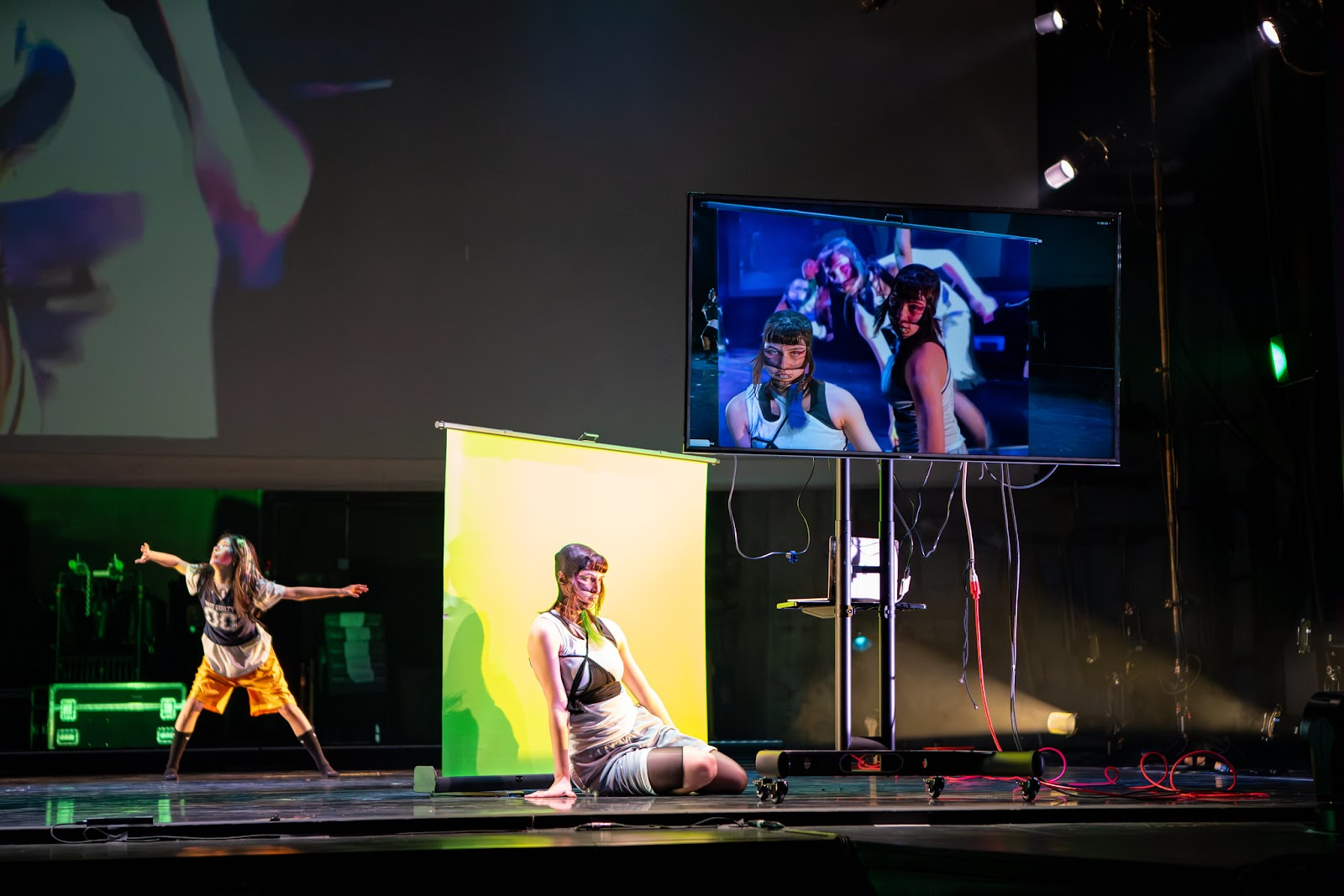
Photographer: Natalie Fiol
This writing recaptures the event of the thesis performance—and the rehearsals that shaped it—by throwing the reader into a choreographic deep dive. Beginning with the COVID lockdown experiments of March 2020 that first led me toward graduate school, the writing unfolds through rehearsal notes, reflections, and musings on writing, ultimately arriving at the staged performance of February 2025.
The central question of both the performance and the writing is: What do I need to do to keep your attention?The “I” here includes myself as a Digital Native, a choreographer, and a dancer. In order to create a dance that communicates the experience of being online, I developed four central terms: choreographic looping, audience as active editor, desktop as stage, and critical choice. These ideas are defined and expanded throughout the text, which plays with form and tone in a way that mirrors the desktop experience and calls into question what it means to engage with a work designed to live in the middle space. One between the online and the IRL.
Part 1: The Screen Was My Studio: Developing Methods
The thesis rehearsals did not begin in a studio and the first performance didn’t take place on a stage but rather: a screen-lit bedroom, somewhere between panic and possibility. Performance happened when I screenshared videos between browser tabs. The only bodily choreography of my body was only that of my fingers. That of looping swipes, scrolls, pinches, and drags. And without a need to pay rent, without a need to rest from exhaustion, without a need to return to work, I swiped, and scrolled and pinched and dragged until the screen glitched, the sound failed, or the batteries died.
My audience was the same screen I stared into all day. And as I stared, I staged my desktop.
Each pixel became information. File names became program notes—fragments of titles, notes to self, a map of intentions. The design of each window, each tab, offered evidence of browser loyalty, update history, and personal rhythm. What began as a daily interface—designed for efficiency, maybe even for war—became a stage. The GUI (graphical user interface), originally engineered to make numerical information human-readable, became a choreographic surface. And I took the time to watch it.
The process felt too silly to matter—and too urgent to ignore.
“What is worth saying right now through the screen?” “What does it mean to make something that wastes no one’s time by feeling new?”
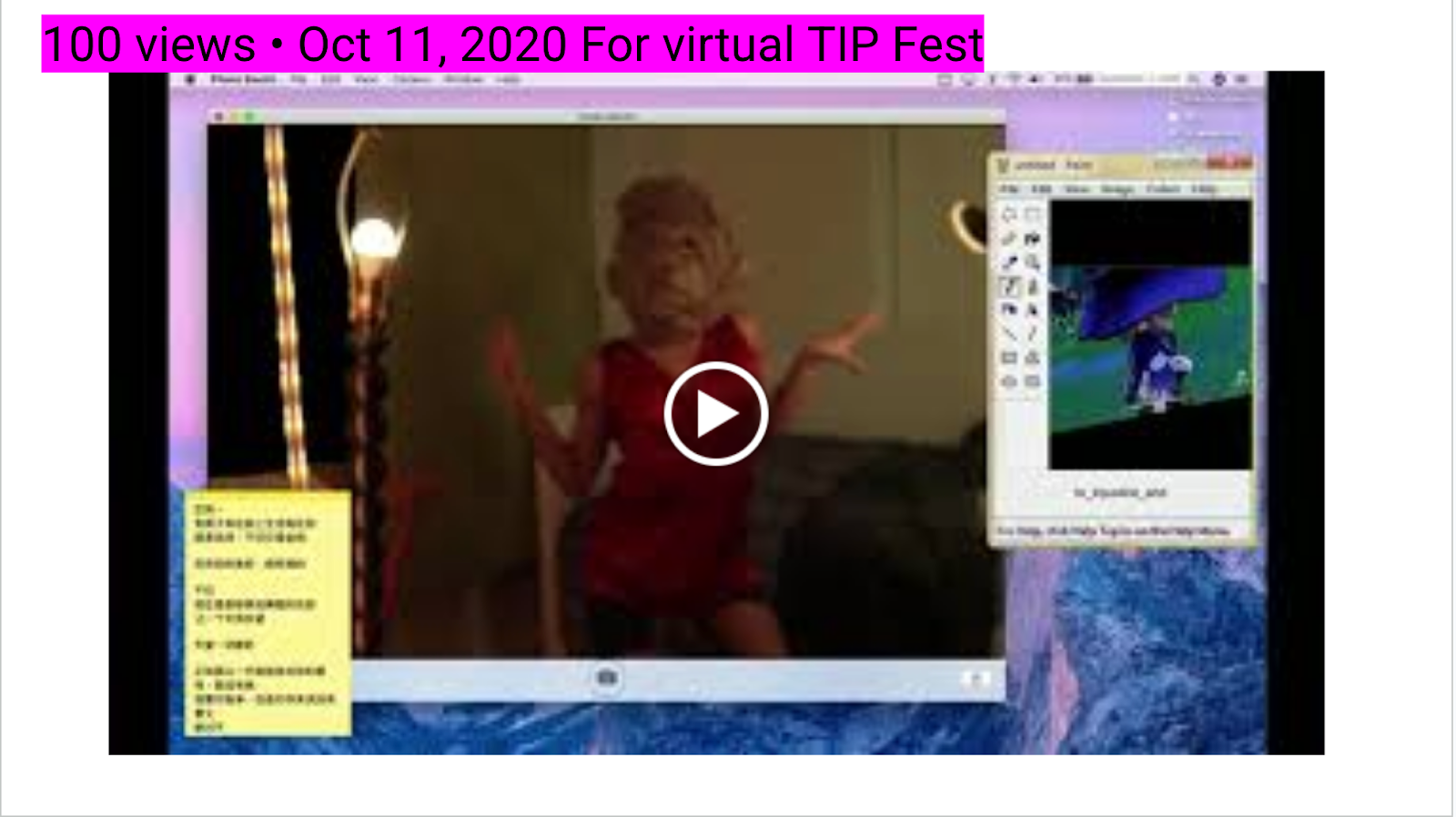
Screenshot from my dance film, Things are Not Fine premiered in October 2020
Notes from creating Things are Not Fine
December 2020 – Chicago, Illinois
I am in Chicago with my mom, my brothers, and our dog, Lucy.This is what I look like today. This is what the sky looks like.Here’s the weather. Here’s my Spotify playlist. Here are my favorite photos right now.
You can see it all on my screen. Are you here?
“I’ve been rethinking time and how to measure it… my camera roll is the closest thing I have to a calendar.”
I’m making things that feel silly. Maybe that’s the point. To try. To keep trying. Even if it fails. I’m spiraling sometimes—into control, into routine, into desire. I feel addicted to the idea of being seen. And terrified of it, too. What if someone else were recording my screen?
I watch drag queens perform on Instagram Live and IGTV, in shows that must have taken hours of prep and always have the risk of collapsing under glitchy WiFi or time limits. In March of 2020, I watch a performance called Oops!. The queens synced their music manually through time.gov, mouthing lyrics together from different bedrooms while passing nail glue and dollar tips digitally between screens, and IRL dropping it on the floor to pick up later. They split their sets to restart when Instagram timed out, and a new aesthetic was built. Faces merged across screens, an improvisation of digital humor, a humor only possible because of the digital. The DIY nature of the performance reframed time as something once again: shared, negotiated, and intimate. There is a whole technical vocabulary being created; I'm Going Live. Send me your Screenshots. Any New Filters? Hey Chat! Hi Chat! Chat! Hey Chat! Whats up Chat!
I have to keep watching to stay in the loop. To stay looping.
Social media platform-native drag, which I first encountered during the endless scrolling of 2020, shaped how I came to understand the digital body as both interface and broadcast. What was being sold was not polish of technology, but the presence of performance. It was a moment that overloaded me with digitally manipulated movement but unfolded within loops. Yes they were too dense to fully process, but because it was drag, it was a bit that was stretched to its most extreme. Its most ridiculous. I could interact with the labor and design of the back stage and it was celebrated. I could comment and question the performers live, I could make them laugh, make them pivot. While on my screen, I had control as an audience member that I did not have in the everyday.
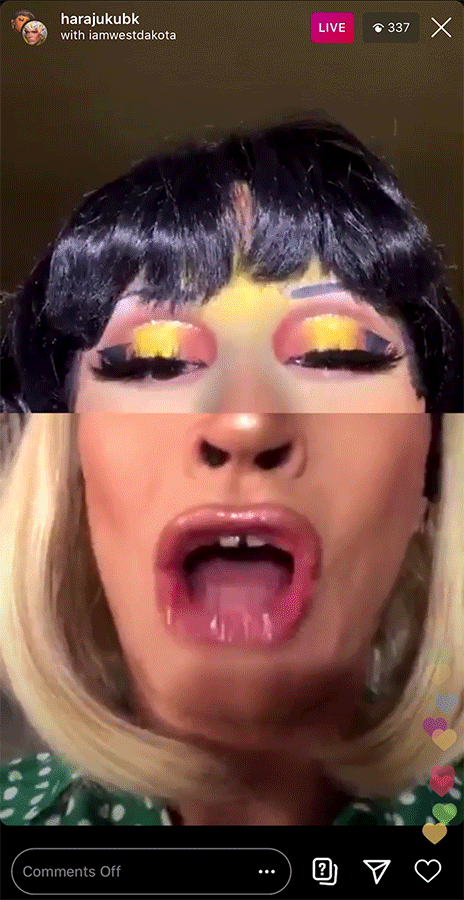
Photo: Courtesy of Oops! / @oopstagramt
Part 2: The Story of Stunning!: Reflections of a transition from Undergraduate to Graduate
May, 2020, Chicago IL, In my mother's basement.
"Relief washed over me as I closed the computer screen. My eyes were sore again. But this time, the screen had performed a transformation. I had undergone a metamorphosis: I was now a college graduate. My degree had been conferred through pixels. Through the screen, I became the first degree-holding Chinese Mexican son in my family."
I spent the months from spring break to graduation sheltering in place—watching, waiting, scrolling. Scrolling, scrolling.
Some time had passed. Some things had happened. I had gone to Taiwan on a Fulbright. I had spent hours running a kindergarten classroom. I learned how to make Zoom work for me. I applied to grad school.
For the audition, I created a Zoom performance around a choreographic exploration of the desktop. Here, I was my own stagehand, my own performer, and my own cameraman. Borrowing from the logic of Oops!, from the logic of the long shot, and from the precariousness of being live, I created a performance that could only exist on the desktop. I was a ballet of stress. Because I was the only performer, I was also the only one who knew all the cues and camera angles. I didn’t need a military-like structure of order and code—but it dawned on me: I might. If I was ever going to work with other people again, the stressful, anxious perfectionism I choreographed from would have to make room for others somehow.
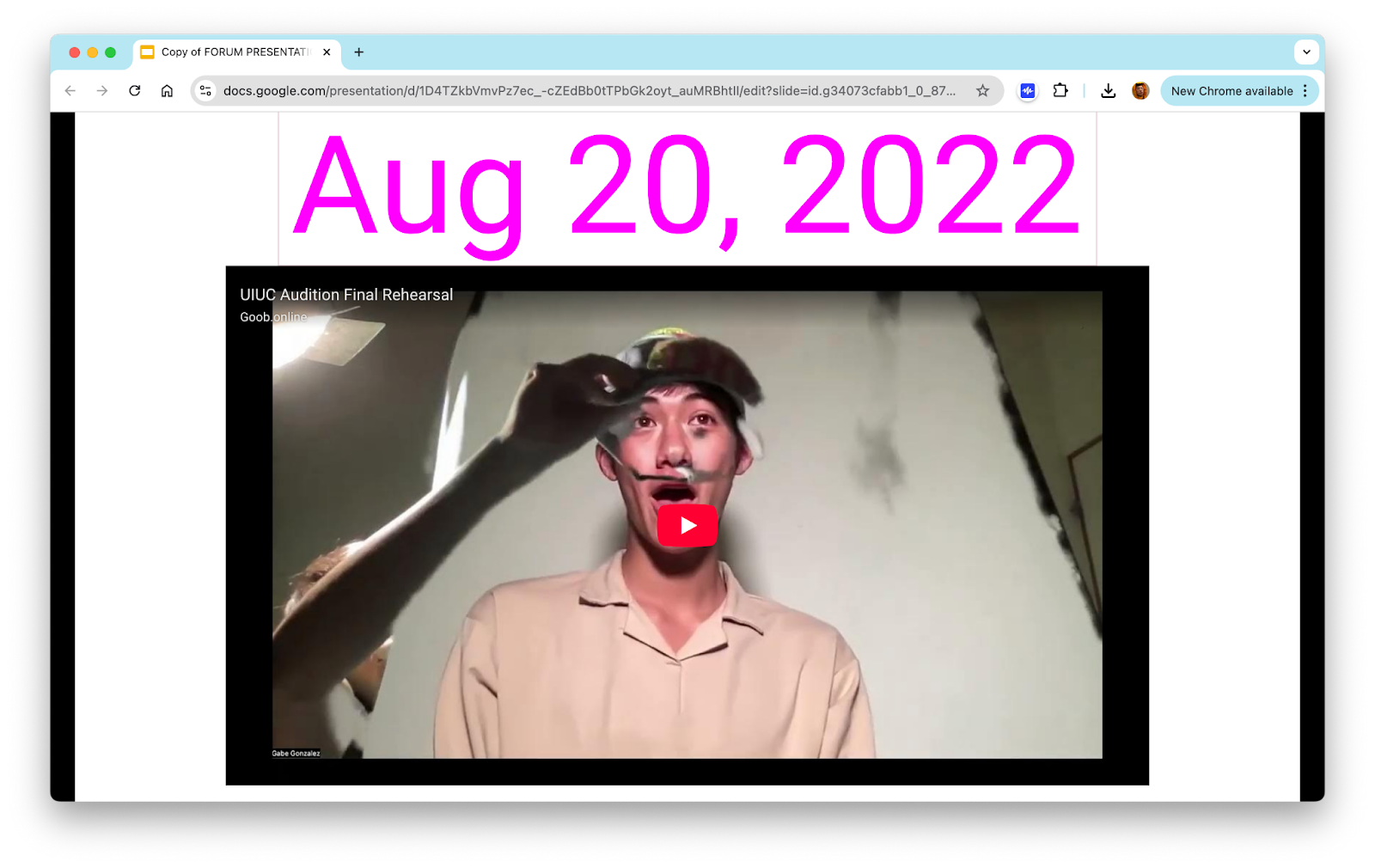
Screenshot of Forum Presentation Slide 119
This was the foundation. The choreography wasn’t just that of my body, but that of: my browser, my posture, my bandwidth. I was building muscle memory for a new kind of performance: one that emerged from stress, screen fatigue, and liveness. I had to consider both what number of steps I could remember, and what storage I had on my computer.
The thesis you’re reading now grew from that solo desktop piece. In 2023, I began developing Stunning! with a cast of undergraduates, not just to replicate what I had done alone, but to test what happens when the stress of the loop is shared.
When the experience of taking cues from a computer's needs denies the pace of the human. When waiting for technology to function, halts the rhythm of performance. When the architecture of becoming a collective is performed.
And when another language is born… a language of Stunning!
Five, six, seven, eight: Screenshotting! Microwaving! Loop two… done.
Dancers worked with me to develop key phrases that united the piece and kept everyone on the same page. It was a secret code, like military language, which intentionally drew upon the history of language that highly organized bodies. Language that was familiar to me. That of; ballet, of my fathers firehouse, of my mothers momisms. Ways that allowed language to have not only meaning but action. Command.
And as we began setting terms, I settled on the title Stunning! because I kept returning to moments of performance that made me feel truly ... Stunning…
Stunning as a word has weight and camp. It’s a joke. It's branding! I imagine people saying "wow that was stunning!" Which is branding! It makes me laugh to feel like I've beaten people to the punch while it also holds the queer history and awkwardness that comes from a professor telling me.
“I want you to know, you are stunning.”
Spoken to me! "I want you to know, I need you to know that you are seen and you are loved and you are worthy. Even if you're pretty clearly doing your own thing here." Hearing this reached into me and spoke to something, and someone I was hiding while living in the corn. I felt a panic arise. I felt seen in a way I didn't know if I was ready for in a space that felt dangerous to be authentic. In Illinois, the role of: teacher of undergrads has caused me to worry about engaging with performance in a way I did not understand until I had space away from it. On campus I felt it necessary for my audience to understand that I, as a student, as a peer, am not the same person as the performer on stage. That I understand that what I do up there is a bit... that I was trying my hardest to be stunning with this clear distinction of curtains closing . . . not that I actually wanted to wear that dress.
A major impetus for how the thesis used technology was my desire to appeal to an audience of engineer students (bridging a gap between humanities and sciences with a piece that is technologically proficient and impressive and relies on its liveness, its elements of performance) choreographic systems that encourages an overwhelmed spectatorshipinclude the audience as active editors, not only has to do with reverse engineering the attention economy, but to hide in plain sight. To create a space where I can become. Ethereal and floaty and beautiful in my fullest form all while retaining the safety of also being hidden.
This is where the loop first came in. Not just as structure—but as strategy. As safety. A way to be exposed and hidden at the same time. To become ethereal and unreachable—while still in plain view. To make the glitch a veil.
In order to create a successful production, the world that the choreography builds must understand the value of engineering emotion through digital manipulation of time, space, light, and audio. To better understand the skills college-aged people have already built as hybrid- learning cyborgs I look at how I first learned to use the performance of the screen as a tool: a place to create beauty. To create Stunning. Stunning-ness.
The process of posting something Stunning is a process of navigating a public market of sexuality within an attention economy. Which feels clearly understood when applying this to an icky truth of how the body of the young dancer acts as bargaining tool and currency.
My choreographic sense of beauty has been irrevocably developed to understand and converse with algorithmic and human-driven metrics of desire. I have been able to curate an online persona based on data, the main currency of the attention economy. Likes, saves, and shares are metrics which shift my understanding of Stunning!, shifting my behaviors around posting and ultimately the images that come to represent me, and provide bargaining power and currency. Posting is my primary method of public-facing time keeping and one of the most consistent written documentation practices I have that includes an investigation of the body. And the screen has an ability to interrupt that. And taking it a step further, by recreating and reposting an image of the self, a selfie, on stage creates a whole new reality for what is Stunning!.
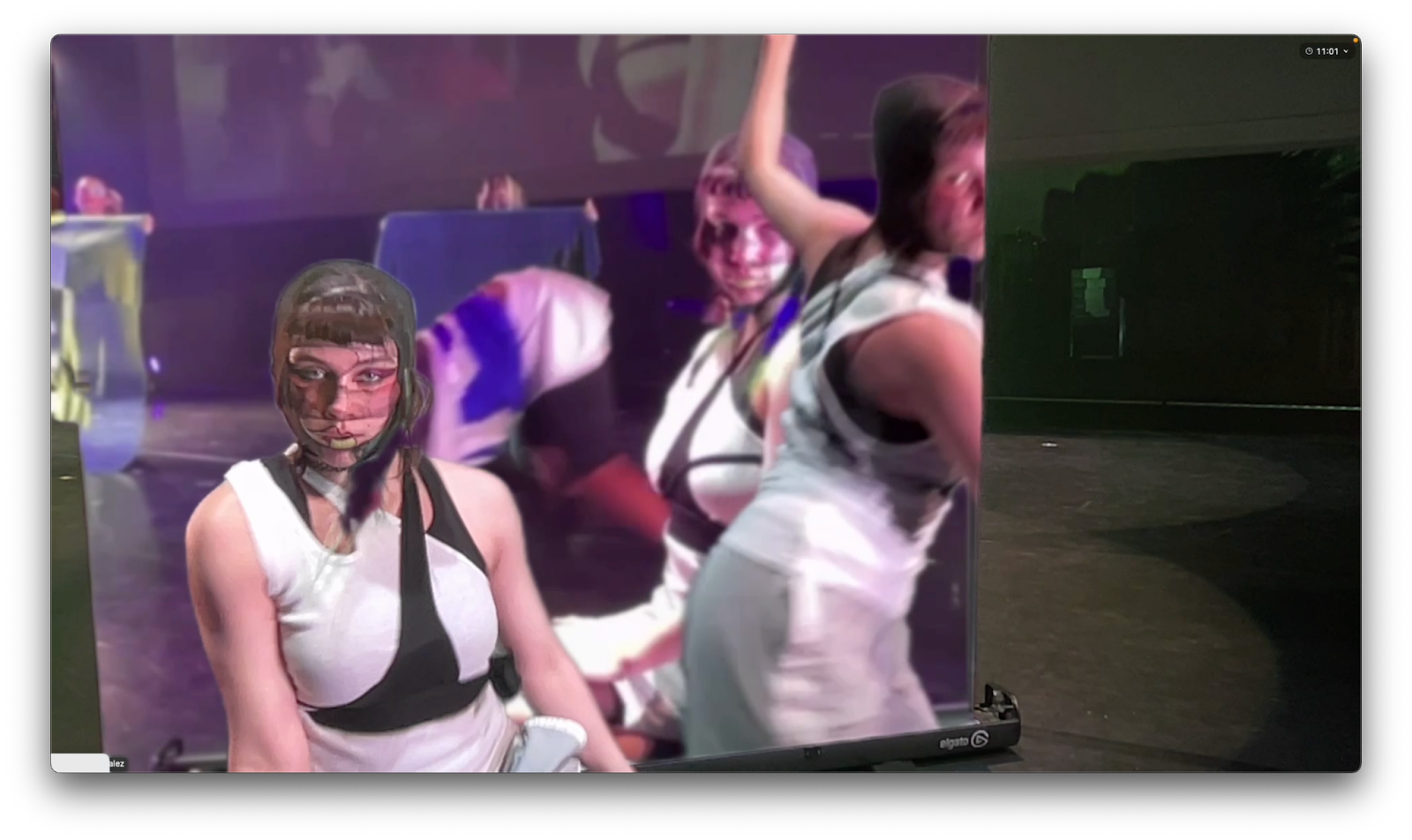
From Stage Left: The Screen Enters
Screenshot from Night 2
Part 3: Notes From Process
As I live here, I find a partner. A gay boy. A Midwestern gay boy.I have him move in. I clean his clothes sometimes.
The summer before year 3 I live off HRI funds and don’t work.
I sit around the house.We share food from his job at the restaurant.I spend my summer cleaning and thinking about the thesis.
I wake up most days with no desire to do the labor that might prepare me for the oncoming violence of a destabilized future. I return to my quarantined state—shuttered, fearful, addicted to seeking comfort.
Through the blue light of the vertical video platform,through the blue light of endless streamable content,through the blue light of the personalized ad… of the perfect algorithm.
I no longer have a need or desire to be in a world that has proven itself so poorly designed for the comfort, safety, or future of community—and of artistic living.
And it is from here that I begin to make a choreography which understands fear as an engineered experience. I want to make the first step towards engineering a better experience on and offline and to do so through a dance space feels like a good skill to build in a world where we're not sure what could happen next. This is the logic the dancing operates under.
I become a broken umbrella sticking out of the garbage. My dangerous metal limbs bent in frightening angles, the roundness of the umbrella now a forgotten illusion when you see me uncovered. My metal monster hand that once provided protection, sanctuary, comfort now betrays you with my true form. The mechanics that make that illusion possible, the engineering of the everyday—failed. glitched.
While in the dance, the dancers must do very serious work, this humor thing, this building a green screen thing. It has an ability to infect the performance, allows it to be throwaway just enough for the chaos and the I don't really know what is happening of the audience to meet a fierce committed cast of bodies on stage. In the audition I look for dancers who are able to live fully in the physical particularity of the movement of glitch that comes out of my body.
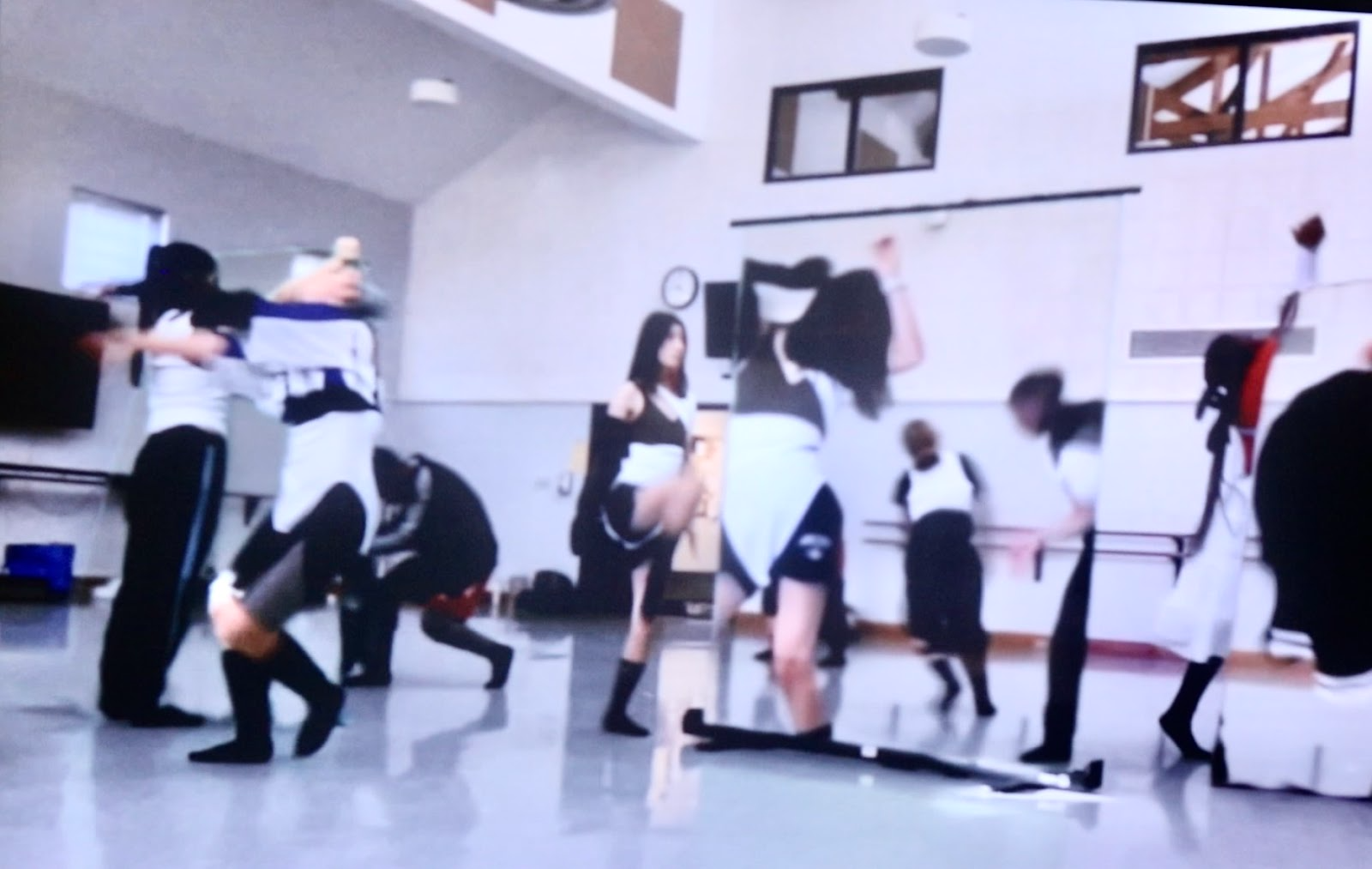
Screenshot of October Rehearsal
Rehearsal Journal: Oct 14–26We begin rehearsals with dancers getting out of their element. Joseph is visiting. I have dancers break into three groups and create a set phrase together to a specific rhythm as I run around to the groups. I give out different suggestions but try to trust their intuition and center it. It is a bit of a chaotic process but I'm interested in their lip sync abilities. An idea I've had for some time now is giving Siri a body so we try it. I copy a link to a google doc and throw it on the screen. I highlight the text and choose 'speak' . The voice is incomprehensibly fast and we have to slow down in order to properly heed its commands. "h t t p s :colon /slash/slash docs . dot google .dot com /slash document /slash d /slash 1one J Z 2two Cy H R V s 5five E H T tio Lmqon 7seven L 5five Ff M ja 5five Q lfwr G v 0zero D nz 7seven Q /slash edit? tab .dot 0zero " Some of the words are sounded out and some just become letters. A rhythm to it forms but it is random. We can't exactly predict it by just looking at it. It becomes a different language. I have them try and speak at the same time as the computer, remembering which parts she takes her own liberties with. As they speak they slowly move to the center of the room and form a clump.
None of this makes it to the final dance. I haven't seen this footage in a long time.
Oct 16th: I teach the dancers how to green screen a screenshot.
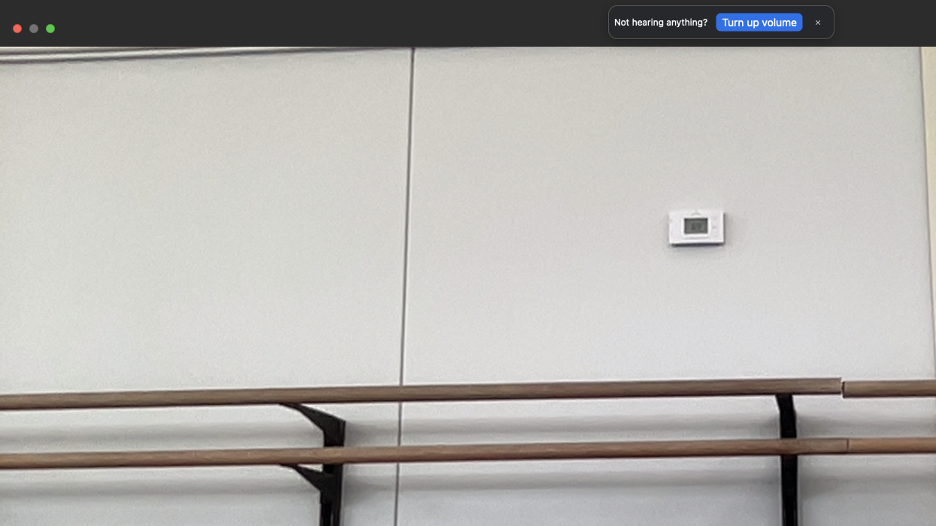
Screenshot from Group 2 Final Loop .mov
October 17th: My 26th birthday. We do so much. I have the cast dance to Yes sir I can Boogie. It's a favorite of mine. I think of the music video as I dance and have the dancers re-learn what I do as choreography. They perform it in a line with one person alternating as a soloist.And because it is my birthday, I think about how astrological signs might have a lot more to do with when your birthday falls in the year than anything else. Today is such a shedding for me, and I'm happy to be dancing with my cast. When I watch back the videos I'm reminded of how much the structuring of what I am making is coming out of my experiences with Graham and Limon.
The drama of a line, the shape of a body in contraction, the weight of the head. It's all here.
And so are these two positions I return to when creating. One is like that of the baby robin that lived in my garage, neck at an impossible angle, mouth agape, helpless. It's my remedy to Screenneck. Screenneck being that awful, cramped, barely looking up position with neck muscles weak and engagement almost entirely from the chin. Eyes are baggy and tired and hands are planted into one's chest lifted from the shoulders and splayed at the keyboard.
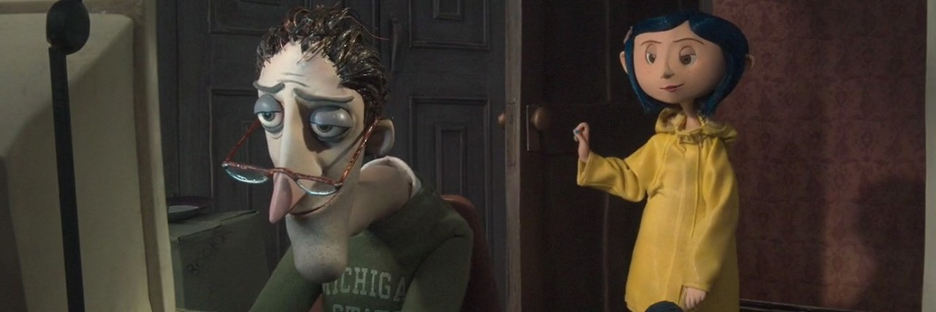
Still from "Charlie Jones On The Computer" Henry Selick (dir.), Coraline, 2009
It is informed by those illustrations in ergonomic chair ads—those grotesque posture diagrams with red glowing pain auras and misshapen human spines.
Posture Check! Posture Check! POSTURE CHECK!
That was me. Bent and melted into a COVID-era Zoom classroom, screen-lit and screaming. I was a broken umbrella.
That bodily condition became the start of my theory. A somatic prompt for rethinking attention, surveillance, and the politics of dancing under conditions of endless scrolling. A distorted form of Haraway’s cyborg—half software update, half ergonomic ghost. I didn’t want to fix my posture. I wanted to choreograph through it.
Like Shotgun Seamstress, this dance builds a lexicon for survival. A coded language for the queer, the weird, the overlooked. Our rehearsal dictionary—terms like “microwaving,” “screen goblin,” “greenup”—was both practical and speculative. It allowed us to name what the software could not. To turn the screen’s flattening language (Update Available, Buffering, Muted) into choreography.
As Claire Bishop reminds us, contemporary spectatorship is hybridized: we are both viewers and content. Language is no longer just shared—it’s performed.
These words were how we rehearsed that new fluency.
Shotgun Seamstress The Complete Zine Collection Osa Atoe:
is a zine by & for Black PUNKS, QUEERS, MISFITS, FEMINISTS, ARTISTS & MUSICIANS, WEIRDOS and the people who support us. This zine is meant to support Black People who exist within predominantly white subcultures, and to encourage the creation of our own.
Stunning!
is a dance by and for Chinese Mexican PUNKS, QUEERS, MISFITS, FEMINISTS, ARTISTS, MUSICIANS, WEIRDOS and the people who support us and the people who came to the show for a grade. This dance is meant to support the Gay and Nonbinary people who exist within the predominantly white university and corn fields, and to create our own world, where despite this whole fucking regime change, we can still be fierce as fuck.
figure 1. Stunning! Vocabulary
Part 4: Lessons from the Performance of Screen Goblins and Other Ergonomic Failures
We started layering more loops for our Zoom-conditioned bodies, our chronically scrolling minds. Loops became the way we approached avatar, performance quality, and attention in our hybrid digital IRL performance. The distinct ways the dancers moved while being watched through the screen was uncovered through the rest of our time in rehearsals and into the performance research.
This section of the thesis brings together the many threads that began to consolidate mid-process and mid-performance: choreography of glitch, looping logic, avatar movement, desktop as stage, audience as active editor. It’s here that theory and rehearsal collide most clearly in answering how dancing bodies respond to the constant demands of optimization, buffering, and upgrades.
Character & Avatar
Donna Haraway writes that "monsters define the limits of community." In our studio, the monster became a method. Whether it appeared as the Screen Goblin, the Ingénue, or the Popstar, each avatar provided a survival mechanism for working inside the spectacle. The avatars were taken from my experience online creating avatars that parallelled writing of authors who use avatars to explore fringe culture like: Dennis Cooper, McKenzie Wark, and Legacy Russell.
Each dancer generated an avatar—part parody, part armor—they were like characters from Dennis Cooper’s The Sluts. This parasocial choreography built in layers of identity performed for no one and everyone. The dancers' sense of self on stage were filtered and refracted through my experience online. The avatars were not an escape; they were intimacy by other means. The moderators, the trolls, the watchers: they all had a role and a movement vocabulary. In this space, the dancers weren’t resisting the loop. They were glitching within it—visibly, messily, politically. Each avatar was both drag and labor. Each freakout, both comedy and critique.
"The monster, when trying to be stunning, feels so so so monstrous. How can you feel stunning?"
The screen goblin starts to anchor downstage left. They become a constant draw of attention that re-stagings time, image, maybe even reality. The dancers get comfortable performing the ridiculous world without losing commitment. For them, the screen has always been there. The Ingenue Experiencing Twink Death enters by screaming like a goblin at about 5 minutes in and completely captures the monstrous beauty of Stunning!. It is weird and feels cramped and too intensely personal to be seen on stage, to see so close. It is a bedroom freakout but with the Zoom camera left on.
Before invited showings or at the top of some rehearsals, I have the dancers try out different ways of wearing their clothes. In one instance, they loop as a bigger group and investigate a falling movement more after wearing their pants as shirts and shirts as underwear. I call it the falling phrase. This is the first time we begin to take some real effort to document how each dancer is playing with how the costume pieces are also the avatar. Sometimes the clothes bunch up like loose skin or hair under netting. Layered in bunched clothes managing glitchy greenscreen props, the dancers weren’t just performing material but building a choreography of refusal. I want the costume to not be afraid of being ugly and to feel uncomfortable but lived in. I want the costume to have a ritual of getting into, a choreography of putting it on, an intimacy and research with the different fabrics. A logging on. Exhausting all ways of draping. Through discomfort, through committing to dress up, through screen time and sweat, we crafted our visual language of refusal: of redesigned attention. This was a rehearsed future where attention isn’t extracted but chosen.
Performance Quality
The movement vocabulary was clarified alongside these avatar experiments. Through full-out dancing with the cast, I found myself choreographing a spider-like, forced high-arch physicality with a teetering, infantile rhythm—one where dancers let their long limbs flail and their boneless feet slap the floor. It was a mix of two monsters. There was no traditional engagement with technique, but rather a desperate locomotion born of rehearsal-as-performance. The drama came from a disorienting doubleness: trained bodies misusing the rigor of Graham and Limon to throw themselves into glitch. That doubleness—first seeded in Zoom classes—carried the ache of being more adaptable than the structures meant to lead us. It manifested in tantrum, refusal, and the impossibility of fitting into the screen—socially, physically, emotionally.
One solo emerged from this stew: a baby Japanese Oni barreling through a village square, stealing liquor bottles, eating raw fish, befriending cranes who bow their necks and lift him into the clouds. The creature was monstrous, but light. Stunning. It began as a parody of Eros and bloomed into something queerer, more excessive, more refusing. I continued to dance full out alongside the cast and found a clarity to the movement vocabulary unavailable to me with words. The solowork that makes up the beginning of the dance came out of this Oni dance and morphed into what I began to think of as the dance of the troll. The internet troll. It is danced with a committed body, a frustrated yet trained body. One who finds beauty in a control of sudden and explosive shifts. A choreography of refusal and individualism.
Music
The rehearsal music for the solo was a self-created mix and the first sketch I was able to give to Cody, my composer. Included in this first mix was: Dream Puppy by The Sweet Enoughs, Infinite Love by Emile Mosseri, and Letter by Alexandre Desplat. They are cinematic and evoke scenes of morphing one's body to conceal oneself while looking at long stretched horizons. A beach, a factory floor, and a wealthy NYC mid century waiting room, somehow they are all within 100 meters of each other, and this solo lives in that musical world.
For the rest of the dance we first rehearsed the Concerto for Water Percussion in Memory of Toru Takemitsu: III Allegro Molto Agitato, which I had heard on the radio while driving to Chicago. The piece is rambunctious, inventive, and unpredictable in a way that lends itself to the dancing quality I sought. The monstrous, forced contractions that came from the screaming tottering monster was dug into differently with this as the score. One invited rehearsal ended with a manual loop of Bella by Jerskin Fendrix and Pu by Arca. This world felt as if they came in the aftermath of a world made from an intense collision, from a monstrous boisterousness. This was the song of getting back to work; changed.
I found language to relay to Cody about what the music should do. It should build into the music of an angry chained guard dog who has been made tired by an endlessly barking an endless chase. The dog is only punished by his own effort, his own passion, when he is yanked back breathless. While the green screens are set up the music should be that of an otherworlds computer booting sequence. One that might remind a listener of hours spent alone building on Minecraft or The Sims. Obsessing over creating a singular structure, a single image. Only to log off one day, lose the file, and never return. Only to grow up and uninstall, to delete memories for some other more important software. Maybe one I can use to make money. The lore, the creations, the loot that once was so precious never to be seen again. The digital — abandoned.
And then the tall Beautiful Man and The English Teacher were having a conversation in French and Chinese. One that mimics an important part of miscommunication in our world. They act as if they can communicate with each other—as if they can communicate with us from behind a scrim and without a script. They perform and speak to each other in a way that language apps and algorithms reward. They order food and speak well crafted vocabulary sentences to their partner, who is a screen.
Who are they training to speak to?
They practice this skill of speaking as if they're on an app in front of us. And we can see the gamification of connection take place. There is the dedication that real language learning takes, one of empathy and difficulty and slow growth. One of being a cultural student. There is no technological savior and I doubt there will be.
There is no current technological innovation that will save us.
There is no tech that will save our humanity.
A melancholic tone of the dance begins to take shape for me as I watch the dance. I am confused for the longest time, but it's because of the mix of the music, and the commitment of the dancers, and the insistence to get this shoddy technology to work wonders, and the animalistic-innovative-sissy-strangeness of the alien baby moves, and the fact that these are all in defiance of an easy fix, of a technological save.
The images that the screen projects back to the audience exist because of the dancers' hard work on stage. There is no easy way to make this dance work, to make the components fit, the costumes organic, the makeup lived-in. It had to be made through the everyday commitment the dancers made to be here. We had to choose to do this dance every day, to struggle through the screen, to put our possible technological failures on display.
"In Another Life, I Would Have Really Liked… Just Doing Laundry… And Taxes With You"
"如果有來生, 我還是會想跟你一起報稅, 開洗衣店"
"Rúguǒ yǒu lái shēng, wǒ hái shì huì xiǎng gēn nǐ - yīqǐ bàoshuì, kāi xǐyī diàn"
In to 2022 film, Everything Everywhere All at Once, during a pivotal final scene, kind hearted Waymond Wang turns to Michelle Yeoh's character and says this. He tells her that she has a choice.
As the dancers create these images, as they move with commitment and humor and intention to build something great, but new, maybe frightening because of its unavoidance the audience gets to choose to look away. You can choose to just see the screen, just see the projection, to not read the program, to not talk to a neighbor, but in this offering they can also choose something else.
The final work begins by ushering the audience into a familiar state of scrolling consumption, then invites them into a logic of looping and layering—of too muchness. The choreography embraces an overload: information, movement, screens, sound. No single pass is enough. The dance is built for multiple readings, multiple entry points. It positions the audience not as passive watchers but as editors of their own attention.
This is a performance that demands choice. Where do you look? What do you remember? Which loop did you follow, and what do you miss? The work doesn't answer—it replays. It builds and breaks, distracts and redirects. And in doing so, it resists the passive habits of algorithmic life.
This is the labor of performance in the age of the scroll: not to escape the loop, but to glitch inside it. Visibly, critically, stunningly.

Member discussion